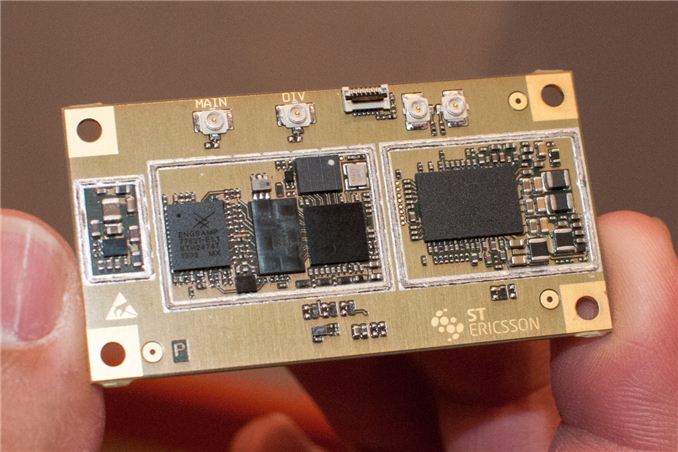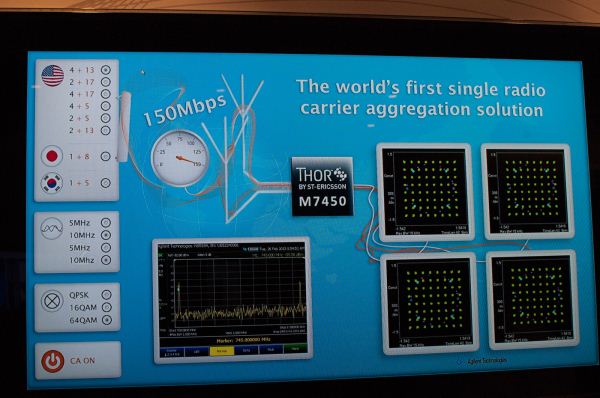A Look at ST-Ericsson's THOR M7450 Category 4 LTE Modem with Carrier Aggregation
by Brian Klug on February 26, 2013 4:39 AM EST- Posted in
- Smartphones
- LTE
- Mobile
- ST-Ericsson
- M7450

Earlier this morning we stopped by ST-Ericsson to talk about their SoCs and modem platforms, and took a look at their new Thor M7450 baseband which includes both support for 10 MHz + 10 MHz carrier aggregation to realize full category 3 and 4 speeds, and of course category 4 support. M7450 is built on a 28nm LP bulk process, though I'm told that there will be future parts also supporting FD-SOI similar to the new L8580. This is the same IP block integrated into ST-E's L8580 SoC, and includes support for both TDD and FDD LTE alongside WCDMA/HSPA+, TD-SCDMA, and GSM, all the 3GPP suite. ST-E believes its modem architecture in M7450 is very different from traditional designs, as it leans more towards being an SDR than most.
We had a chance to see M7450 demonstrating both UE Category 4 speeds and carrier aggregation on a number of different band combinations, interestingly enough 4 + 17 (AT&T), 4 + 13 (VZW), and 2 + 17 (AT&T) in addition to a few others. M7450 of course supports 5+10 and 5+5 aggregation as well.
Anand and I also got a chance to check out M7450 doing a VoLTE voice over IMS call running AMR-WB on the platform, which touts power consumption on a VoLTE call at levels equal to or less than a WCDMA call. There was a visualization showing the platform performance on the current VoLTE call versus WCDMA (for the same platform) which was at the same level or below basically the entire time. M7450 is currently sampling and expected to be in devices by the end of the year.

















15 Comments
View All Comments
MadMan007 - Tuesday, February 26, 2013 - link
Article needs more acronyms!JeffFlanagan - Tuesday, February 26, 2013 - link
Acronyms aren't a problem, but the author failed to define them, making the article gibberish.tunaman - Tuesday, February 26, 2013 - link
Some customers may ditch them for this chip?https://url.odesk.com/~44f2nc
UzairH - Tuesday, February 26, 2013 - link
The fudge does some cheaparse speaker-grille Chinese website have to do with radio modems?Am so sick of these annoying advertisers on EVERY forum on the interwebz.
jamyryals - Tuesday, February 26, 2013 - link
Any announced design wins for it yet?FaaR - Tuesday, February 26, 2013 - link
"ST-E believes its modem architecture in M7450 is very different from traditional designs, as it leans more towards being an SDR than most."...Wut? :P
lever_age - Tuesday, February 26, 2013 - link
ST-E = ST-Ericsson = joint venture of companies STMicroelectronics and EricssonM7450 = new baseband chip (brains and workhorse behind sending / receiving data; the part other than the actual antenna and amplifier hardware)
SDR = software-defined radio; this generally means that more of the functionality is being implemented in software / firmware on more flexible hardware, rather than fixed-function hardware blocks -- some advantages could be reusing hardware components when switching between different technologies (just load up different instructions), and so on
So some company claims to have a new wireless communications chip that's more flexible and advanced than others on the market.
ganfuj - Monday, March 11, 2013 - link
if M7450 is just the baseband chip, what did they use for teh transceiver for the demonstration?It is the transceiver that is more challenging. Until they have a companion transceiver doing the CA (carrier Aggregation ) this is just marketing piece.
Zink - Tuesday, February 26, 2013 - link
And: "M7450 of course supports 5+10 and 5+5 aggregation"Are there maybe a few hundred people in the world that would know that a new baseband from ST-Ericsson "of course" supports whatever that is? Brain writes and says "of course", "interestingly enough" and "you know..." without explaining what he means probably a bit too often but it makes me feel smart when I understand what he is trying to get at.
lever_age - Wednesday, February 27, 2013 - link
I'd never heard of this baseband or most basebands in general (and I don't too much follow industry wireless technologies), but near the top of the article, it's stated that 10 MHz + 10 MHz carrier aggregation is supported. That's probably referring the bandwidth used at a given carrier frequency. Actually, I'm not sure if I've ever heard of "carrier aggregation" as a terminology, but it's not too much of a stretch to have heard of that or to infer that it means to use multiple carriers simultaneously.If it supports 10 + 10, then it's not much of a stretch to understand what 5 + 10 and 5 + 5 mean in this context (5 MHz as opposed to 10 MHz bandwidth, which just means a lower signalling rate... or is this some OFDM system and it's just using less subcarriers? probably). See the second box in the second picture. IIRC these things usually support either 10 or 5 (so to speak), so if it can do 10 + 10, it can do the other easier combinations too.
All that said, I agree that this is a rather hastily-written article with too much jargon and not enough explanations, even for Pipeline. I'm definitely going to admit that being an EE grad student in communications helps me out here.